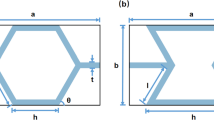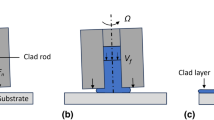Abstract
In this study, the thickness was set as the variable and TDCB specimen was designed in order to investigate the adhesion strength characteristics of the slip mode made from aluminum foam. The dimensions of the models are the length of 200 mm and various thicknesses of 15 mm, 30 mm, 45 mm, and 75 mm. According to analysis results of the model with 15 mm thickness, when the forced displacement became about 5.3 mm, the maximum load appeared to be 188 N and a maximum equivalent stress of about 2.99 MPa occurred, respectively. According to the analysis results of specimens, when the propagation of the forced displacement is about 5.3 mm, a maximum reaction force of about 940 N appears whereas when the propagation of the forced displacement is about 22 mms, the reaction force almost disappears. When the trend of experiments and analysis results are applied to the four models used in this study, the adhesion strength of TDCB adhesive structure made from the aluminum foam of varying thickness can be evaluated. Therefore, it is expected that the structural safety can be anticipated by only an analysis without experiments in the actual adhesive structure.
Similar content being viewed by others
References
Bai, Y., Johnson, W., and Dodd, B., “On Tangential Velocity Discontinuities Being Coincident with Stress Discontinuities,” International Journal of Mechanical Sciences, Vol. 24, No. 5, pp. 323–328, 1982.
Kim, S.-S., Han, M.-S., Cho, J.-U., and Cho, C.-D., “Study on the Fatigue Experiment of TDCB Aluminum Foam Specimen Bonded with Adhesive,” Int. J. Precis. Eng. Manuf., Vol. 14, No. 10, pp. 1791–1795, 2013.
Parida, S. K. and Pradhan, A. K., “3D Finite Element Analysis of Stress Distributions and Strain Energy Release Rates for Adhesive Bonded Flat Composite Lap Shear Joints Having Pre-Existing Delaminations,” Journal of Mechanical Science and Technology, Vol. 28, No. 2, pp. 481–488, 2014.
Batra, R. and Peng, Z., “Development of Shear Bands in Dynamic Plane Strain Compression of Depleted Uranium and Tungsten Blocks,” International Journal of Impact Engineering, Vol. 16, No. 3, pp. 375–395, 1995.
Mukai, T., Miyoshi, T., Nakano, S., Somekawa, H., and Higashi, K., “Compressive Response of a Closed-Cell Aluminum Foam at High Strain Rate,” Scripta Materialia, Vol. 54, No. 4, pp. 533–537, 2006.
Cho, J. U., Hong, S. J., Lee, S. K., and Cho, C., “Impact Fracture Behavior at the Material of Aluminum Foam,” Materials Science and Engineering: A, Vol. 539, pp. 250–258, 2012.
Pirondi, A. and Nicoletto, G., “Fatigue Crack Growth in Bonded DCB Specimens,” Engineering Fracture Mechanics, Vol. 71, No. 4, pp. 859–871, 2004.
Shokrieh, M. M., Heidari-Rarani, M., and Rahimi, S., “Influence of Curved Delamination Front on Toughness of Multidirectional DCB Specimens,” Composite Structures, Vol. 94, No. 4, pp. 1359–1365, 2012.
Blackman, B. R. K., Dear, J. P., Kinloch, A. J., Macgillivray, H., Wang, Y., et al., “The Failure of Fibre Composites and Adhesively Bonded Fibre Composites under High Rates of Test,” Journal of Materials Science, Vol. 30, No. 23, pp. 5885–5900, 1995.
Marzi, S., Biel, A., and Stigh, U., “On Experimental Methods to Investigate the Effect of Layer Thickness on the Fracture Behavior of Adhesively Bonded Joints,” International Journal of Adhesion and Adhesives, Vol. 31, No. 8, pp. 840–850, 2011.
Cho, J.-U., Kinloch, A., Blackman, B., Rodriguez, S., Cho, C.-D., and Lee, S.-K., “Fracture Behaviour of Adhesively-Bonded Composite Materials under Impact Loading,” Int. J. Precis. Eng. Manuf., Vol. 11, No. 1, pp. 89–95, 2010.
Cooper, V., Ivankovic, A., Karac, A., McAuliffe, D., and Murphy, N., “Effects of Bond Gap Thickness on the Fracture of Nano-Toughened Epoxy Adhesive Joints,” Polymer, Vol. 53, No. 24, pp. 5540–5553, 2012.
Ghaffarzadeh, H. and Nikkar, A., “Explicit Solution to the Large Deformation of a Cantilever Beam under Point Load at the Free Tip using the Variational Iteration Method-II,” Journal of Mechanical Science and Technology, Vol. 27, No. 11, pp. 3433–3438, 2013.
Ikegami, K., Fujii, T., Kawagoe, H., Kyogoku, H., Motoie, K., et al., “Benchmark Tests on Adhesive Strengths in Butt, Single and Double Lap Joints and Double-Cantilever Beams,” International Journal of Adhesion and Adhesives, Vol. 16, No. 4, pp. 219–226, 1996.
Goncalves, J., De Moura, M., and De Castro, P., “A Three-Dimensional Finite Element Model for Stress Analysis of Adhesive Joints,” International Journal of Adhesion and Adhesives, Vol. 22, No. 5, pp. 357–365, 2002.
K. S. Kim, J. S. Yoo, Y. M. Yi and C. G. R. Kin. “The Strength and Failure Modes and of Singlelap Adhesively Bonded Composite Joints Formed Using Different Bonding Methods-Co-Curing with/without Adhesive and Secondary Bonding,” Composite Structures, Vol. 25, pp. 45, 2005.
Crocombe, A. D. and Richardson, G., “Assessing Stress State and Mean Load Effects on the Fatigue Response of Adhesively Bonded Joints,” International Journal of Adhesion and Adhesives, Vol. 19, No. 1, pp. 19–27, 1999.
Briskham, P. and Smith, G., “Cyclic Stress Durability Testing of Lap Shear Joints Exposed to Hot-Wet Conditions,” International Journal of Adhesion and Adhesives, Vol. 20, No. 1, pp. 33–38, 2000.
Casas-Rodriguez, J. P., Ashcroft, I. A., and Silberschmidt, V. V., “Damage Evolution in Adhesive Joints Subjected to Impact Fatigue,” Journal of Sound and Vibration, Vol. 308, No. 3, pp. 467–478, 2007.
Fersini, D. and Pirondi, A., “Analysis and Modelling of Fatigue Failure of Friction Stir Welded Aluminum Alloy Single-Lap Joints,” Engineering Fracture Mechanics, Vol. 75, No. 3, pp. 790–803, 2008.
Bussu, G. and Irving, P., “The Role of Residual Stress and Heat Affected Zone Properties on Fatigue Crack Propagation in Friction Stir Welded 2024-T351 Aluminium Joints,” International Journal of Fatigue, Vol. 25, No. 1, pp. 77–88, 2003.
Author information
Authors and Affiliations
Corresponding author
Rights and permissions
About this article
Cite this article
Sun, H.P., Cho, J.U. Simulation analysis and experimental verification for the adhesive strength properties of aluminum foam specimen for the slip mode. Int. J. Precis. Eng. Manuf. 16, 2529–2535 (2015). https://doi.org/10.1007/s12541-015-0324-6
Received:
Revised:
Accepted:
Published:
Issue Date:
DOI: https://doi.org/10.1007/s12541-015-0324-6




